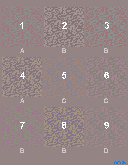|
|
|
Our Tech Examples Applications FAQ Index Sales
|
If you're considering color machine vision software...
If your inspection task involves only recognition of uniformly colored objects in a uniform lighting environment you probably don't need to read this page. In fact you might not even need color machine vision.
|
|||
Can the system differentiate multicolored, randomly oriented and/or complex-shaped objects?
|
|||
|
|||
How long does the training take?It takes less than 5 minutes to manually train WAY-2C to recognize all patterns in the above test image. It takes only a few seconds for the same training from a prepared script file.
|
|||
Is new training required on more than one class every time a class is added, substituted, or removed?WAY-2C usually requires training only on the new class, or when the camera, lighting, or framegrabber is changed.
|
|||
Downloading images for testing.You are authorized to download any images on this website for the sole purpose of vision system evaluation. Publication in any form other than short excerpts for review purposes requires the express written permission of the author.All our images have been obtained from actual inspections or inspection demonstrations. All images (except for the specially constructed test patterns) will have lost a little information as a result of compression (to JPG or GIF) but still should be adequate for most tests. We also have a secret cache of unpublished test images available on request in case you want to verify that a potential system supplier has not made up special "ad hoc" solutions for our published examples.
|
|||
Color based recognition done correctly can be easy, robust and reliable. Color based recognition done incorrectly can be tedious, frustrating and often unreliable. |
